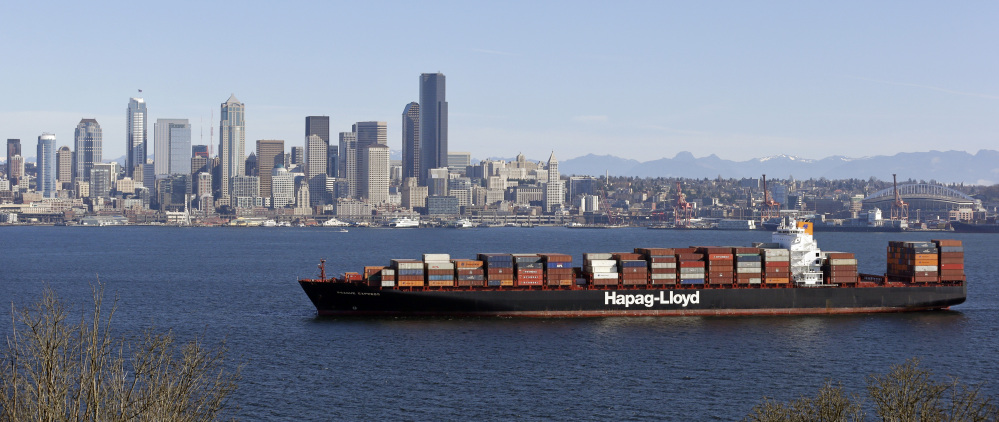WASHINGTON — Hardware Sales Inc. of Bellingham, Washington, does about 25 percent of its online business outside the United States. But going global can be frustrating. Overzealous Australian customs inspectors sometimes confiscate perfectly legal knives. Canada imposes duties that can double the cost of a hammer.
And then there’s the paperwork required to export:
“I don’t like to have an employee go through 2,000 pages of rules to ship a drill,” says Steve Douge, director of e-commerce for Hardware Sales, which sells over eBay, Amazon and its own website.
A solution may be coming.
The United States is negotiating an ambitious trade accord with 11 other Pacific Rim countries that’s meant to ease barriers to fast-growing Asia-Pacific markets and streamline customs rules that can bedevil exporters like Hardware Sales.
Yet the Trans-Pacific Partnership, or TPP, is also stirring opposition. Critics say it will destroy U.S. jobs, allow multinational corporations to sidestep laws they don’t like and let drug companies use stricter patent protections to drive drug prices beyond the reach of patients in poor countries.
The 12 countries involved have been negotiating this week in Hawaii and appear to be moving toward a deal. Here are some questions and answers about it:
Q. What would the deal do?
A: The TPP would erase most tariffs and other barriers to trade and investment among the United States, Australia, Brunei, Canada, Chile, Japan, Malaysia, Mexico, New Zealand, Peru, Singapore and Vietnam. Combined, these countries supply 40 percent of the world’s economic output. The deal would also clarify and standardize trade rules.
Q: What about China?
A: China, the world’s No. 2 economy, is conspicuously missing. In fact, the trade deal reflects Washington’s attempts to counter Chinese influence in the Pacific Rim. China, for its part, is trying to round up countries, including TPP prospects Brunei, Malaysia, Singapore and Vietnam, for its own Asia-Pacific trade bloc. Rival U.S. and Chinese negotiating teams sometimes pass each other on their way in and out of government offices in the region. Still, it’s possible China could eventually join the TPP.
Q: Would it be better than other deals, like NAFTA?
A: TPP is being negotiated in the shadow of 1994’s North American Free Trade Agreement. NAFTA, a deal with Mexico and Canada, failed to deliver the big job gains its supporters had predicted. And it’s blamed by critics for the loss of many U.S. manufacturing jobs. In his State of the Union address in January, Obama conceded that “past trade deals haven’t always lived up to the hype.”
Administration officials insist the TPP would improve upon the agreements that preceded it. They say it will, for example, include stronger measures to block countries from gaining a competitive edge by weakening environmental and labor rules.
Some environmental groups say they’re optimistic.
Q: So what’s the case against it?
A: Critics, led by major trade unions, complain that the deal is being negotiated in secret and that it favors multinational corporations over workers and consumers. The administration says it’s briefed members of Congress or their staffs hundreds of times on the deal and allowed lawmakers to view the work in progress.
Critics are troubled, in part, because they say the deal so far:
• Does nothing about countries like Japan that give their exporters an edge by devaluing their currencies to make their goods cheaper on world markets. Such unfair competition could cost American jobs, critics say.
• Would let companies challenge government laws and regulations on the ground that they inhibit trade. The cases would be decided by private tribunals, a system that critics say bypasses democratic accountability.
• Strengthens patent protections that could bar cheaper generic drugs from reaching patients in poor countries. Researchers from George Washington University and three Australian universities predicted that TPP could reduce, from 83,000 to 37,000, the number of Vietnamese HIV patients with access to antiretroviral medicines.
The reason: By blocking some low-priced alternatives, they calculated, the trade accord would drive the annual cost of the medicines to as high as $501 – nearly quadruple today’s $127.
Supporters of TPP note that the agreement is still being worked out. They say it will likely include provisions to help Vietnam, the poorest of the TPP countries, maintain access to lower-cost medicines, at least for a while.
Q: So would TPP likely create or kill U.S. jobs?
A: Probably neither. The jobs created by greater access to Asia-Pacific markets would likely be offset by U.S. jobs lost to increased competition. And the deal would increase U.S. incomes only $77 billion a year – 0.4 percent – by 2025, according to calculations by Peter Petri, professor of international finance at Brandeis University.
“The numbers won’t knock your socks off,” Petri says.
Copy the Story LinkSend questions/comments to the editors.



Success. Please wait for the page to reload. If the page does not reload within 5 seconds, please refresh the page.
Enter your email and password to access comments.
Hi, to comment on stories you must . This profile is in addition to your subscription and website login.
Already have a commenting profile? .
Invalid username/password.
Please check your email to confirm and complete your registration.
Only subscribers are eligible to post comments. Please subscribe or login first for digital access. Here’s why.
Use the form below to reset your password. When you've submitted your account email, we will send an email with a reset code.